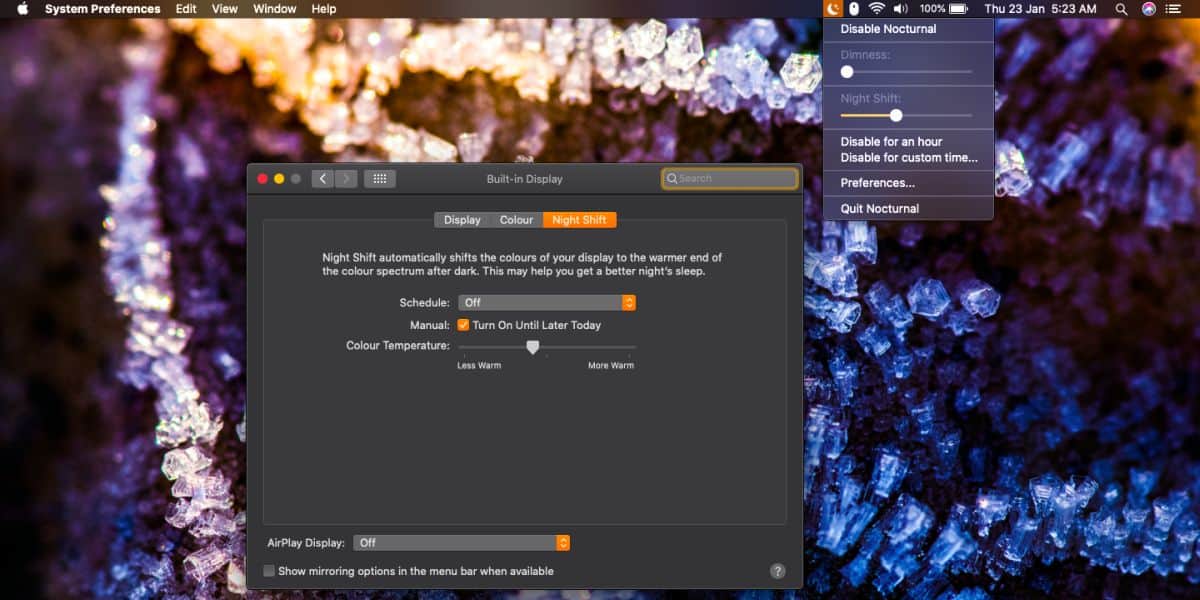
There’s now a burgeoning market in blue light filters: effectively screen protectors that help to block out blue light on your most commonly-used devices. Get some amber light before you go to sleep (Image credit: TechRadar) Blue light filters
#NIGHT SHIFT ON MAC BLUE LIGHT FILTER HOW TO#
How to enable Chrome dark mode on any device.Dark mode generally turns automatically white backgrounds to black (or a dark color) to reduce the amount of light being emitted, hopefully reducing eye strain. The much-discussed dark mode, too, is something available on a host of different devices and apps. The issue with both Night Shift and f.lux is that they give screens a reddish or orange tint towards the end of the day – which isn’t ideal for watching Netflix shows or enjoying pretty much anything in its original colors.
#NIGHT SHIFT ON MAC BLUE LIGHT FILTER SOFTWARE#
You may already be aware of software fixes for blue light, such as Apple’s Night Shift setting, which reduces levels of blue light, according to the time in your region, to reduce the intensity of the display: “Night Shift automatically adjusts the colours of your display to the warmer end of the spectrum – making the display easier on your eyes.”į.lux is a similar program available for Mac, PC, iOS and Android. The proximity of LED screens to our eyes means we're getting a lot of blue light (Image credit: Pixabay) Blue light: night shift, dark mode, and f.lux Other studies have suggested positive benefits to limiting blue light exposure or using filters, like this one (via GoodHousekeeping (opens in new tab)). The higher brightness of many smartphones these days, though – even those with OLED panels, like the iPhone X – means you might be getting even more blue light than with an older LCD device (via f.lux (opens in new tab)) OLED TVs, for one, are generally dimmer, with better brightness control – while many LCD TVs make use of blue LED backlights with color filters. It's worth noting that OLED screens – like those used in LG's OLED TVs like the LG CX, or even the Samsung Galaxy S10 smartphone – generally use less blue light than traditional LED lighting technologies too (via FlatPanelsHD (opens in new tab)).

As ever, it’s good advice to take regular breaks from your screen, look out the window (if you have one), and walk about when you can to vary the distance your eyes are focusing on. Lots of uninterrupted screen time can absolutely irritate your eyes, though the issue may simply be because you’re focusing your attention at a fixed distance for hours on end, and therefore straining your vision. The issue is fuzzier around eye health, though (more on this further down).
:max_bytes(150000):strip_icc()/001-enable-night-shift-on-mac-4137316-19be640c13eb42ffa36a840dfd054383.jpg)
Harvard Health (opens in new tab) cites numerous medical studies making a strong case for melatonin suppression by blue light – and specifically recommends people “avoid looking at bright screens beginning two to three hours before bed.” This is great for keeping you active in the late hours for a big project deadline, or if you’re trying to stay awake, but it’s not as great when you’re trying to sleep. The issue is when that blue light comes at times – say, late in the day – that mess with your circadian rhythm, telling your brain that it isn’t yet time to shut down for bed.

The important thing to remember is that blue light is a natural part of sunlight, and helps to keep us alert.

We wouldn’t be doing our job if we didn’t come armed with some good, hard facts. OLED smartphones emit a lot less blue light than LED displays (Image credit: Shutterstock) Blue light: the science


 0 kommentar(er)
0 kommentar(er)
